air conditioning TOYOTA FJ CRUISER 2010 1.G User Guide
[x] Cancel search | Manufacturer: TOYOTA, Model Year: 2010, Model line: FJ CRUISER, Model: TOYOTA FJ CRUISER 2010 1.GPages: 439, PDF Size: 11.02 MB
Page 209 of 439
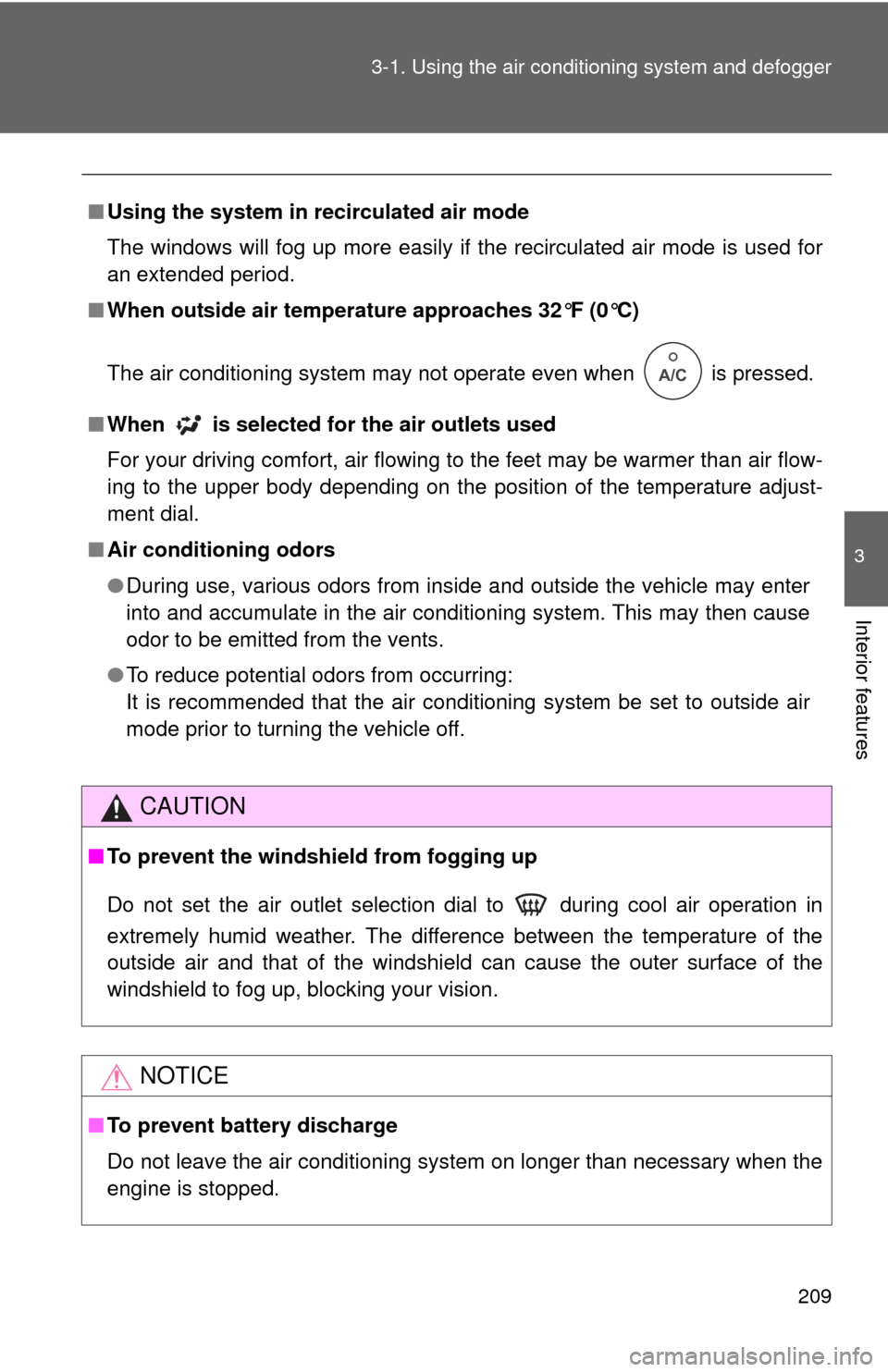
209 3-1. Using the air conditioning system and defogger
3
Interior features
■Using the system in recirculated air mode
The windows will fog up more easily if the recirculated air mode is used for
an extended period.
■When outside air temperature approaches 32°F (0°C)
The air conditioning system may not operate even when
is pressed.
■When
is selected for the air outlets used
For your driving comfort, air flowing to the feet may be warmer than air flow-
ing to the upper body depending on the position of the temperature adjust-
ment dial.
■Air conditioning odors
●During use, various odors from inside and outside the vehicle may enter
into and accumulate in the air conditioning system. This may then cause
odor to be emitted from the vents.
●To reduce potential odors from occurring:
It is recommended that the air conditioning system be set to outside air
mode prior to turning the vehicle off.
CAUTION
■To prevent the windshield from fogging up
Do not set the air outlet selection dial to during cool air operation in
extremely humid weather. The difference between the temperature of the
outside air and that of the windshield can cause the outer surface of the
windshield to fog up, blocking your vision.
NOTICE
■To prevent battery discharge
Do not leave the air conditioning system on longer than necessary when the
engine is stopped.
A/C
Page 210 of 439
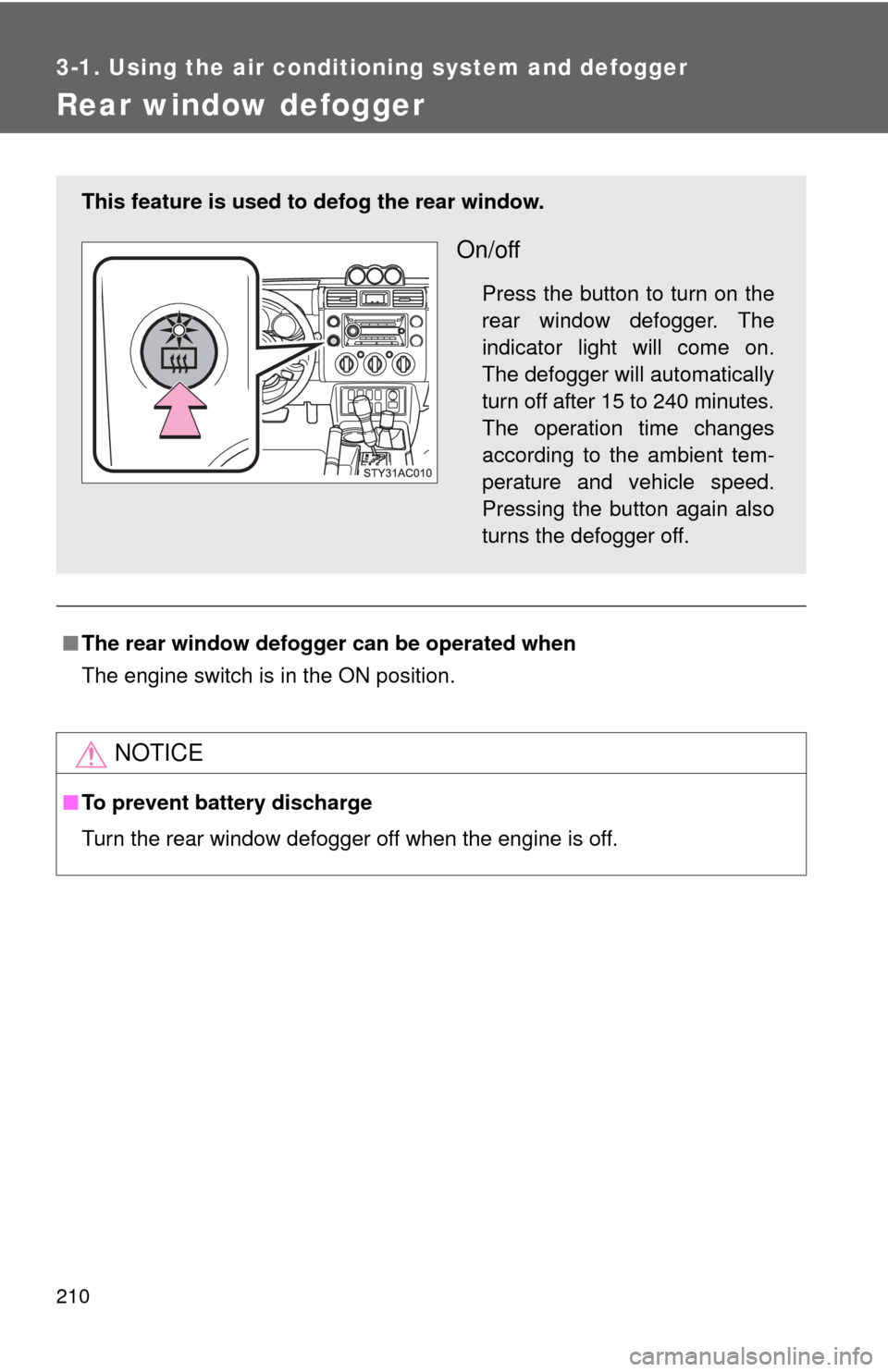
210
3-1. Using the air conditioning system and defogger
Rear window defogger
■The rear window defogger can be operated when
The engine switch is in the ON position.
NOTICE
■To prevent battery discharge
Turn the rear window defogger off when the engine is off.
This feature is used to defog the rear window.
On/off
Press the button to turn on the
rear window defogger. The
indicator light will come on.
The defogger will automatically
turn off after 15 to 240 minutes.
The operation time changes
according to the ambient tem-
perature and vehicle speed.
Pressing the button again also
turns the defogger off.
Page 264 of 439

264 3-5. Other interior features
NOTICE
■Appliances that may not operate properly (115V AC)
The following 115V AC appliances may not operate even if their power con-
sumption is under maximum capacity.
●Appliances with high initial peak wattage
●Measuring devices that process precise data
●Other appliances that require an extremely stable power supply
■To prevent the battery from being discharged
Turn off all the vehicle’s electronic equipment and accessories, such as the
headlights and air conditioning, when electrical appliances that consume in
excess of 100W are used continuously for long periods of time.
■To prevent any damage caused by heat
Do not use any electrical appliances that give off intense heat such as toast-
ers, in any locations including the internal or external trim, seats and deck.
●Do not use any electrical appliances, which are easily affected by vibration
or heat, inside the vehicle.
Vibration while driving, or the heat of the sun while parking, may result in
damage to those electrical appliances.
■If any electrical appliances are to be used while driving
Securely fasten both the appliances and their cables to prevent them from
falling or getting caught any of the power train components.
■If the power outlet is loose when an electrical appliance plug is con-
nected
Replace the outlet.
Contact a Toyota dealer for any necessary replacements.
■If the power outlet gets dirty
Turn the main switch off and use a soft, clean cloth to wipe it gently.
Do not use any cleansing materials, such as organic solvents, wax, or com-
pound cleaners, as these may damage the power outlet or cause it to mal-
function.
Page 277 of 439
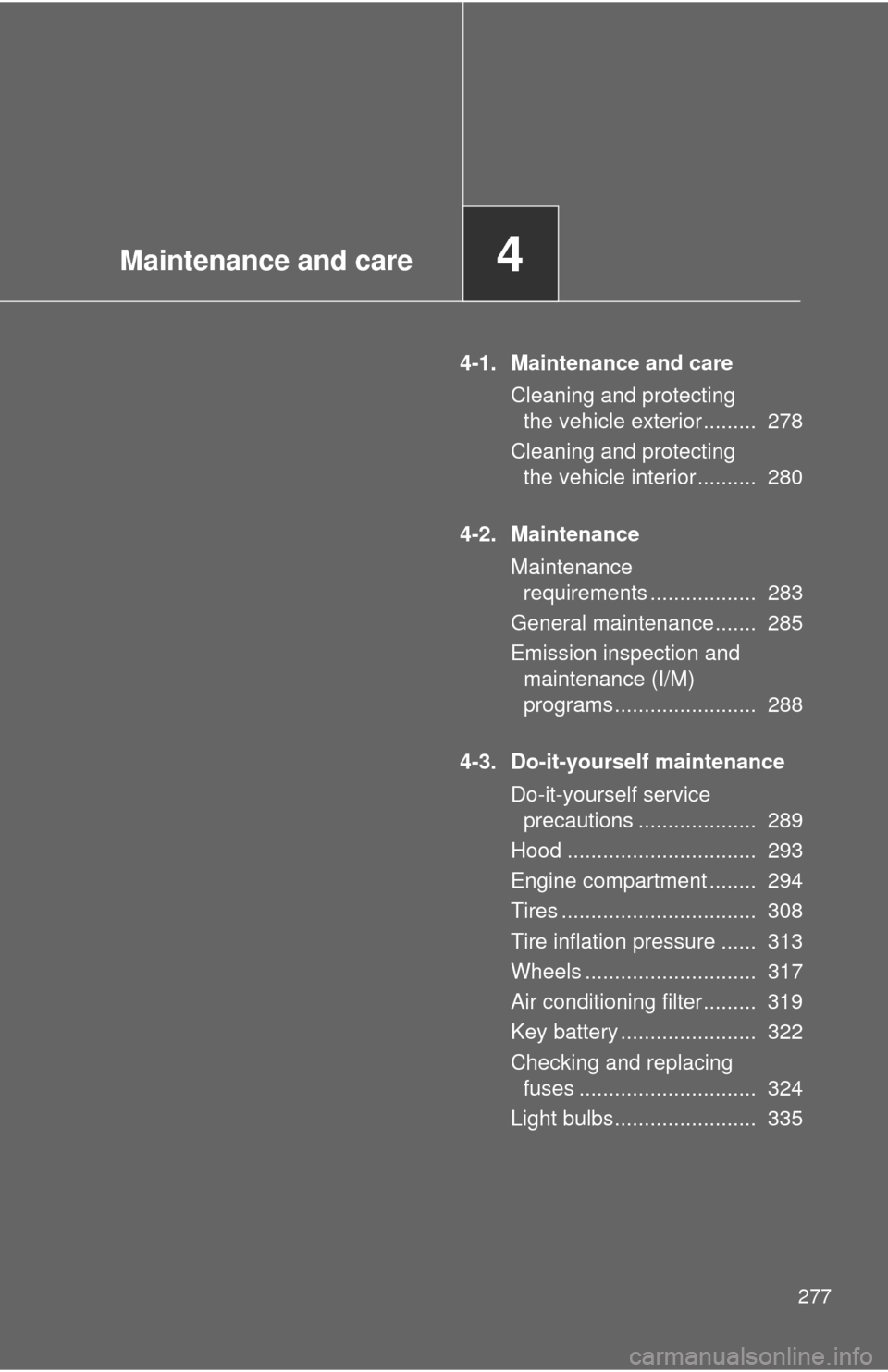
Maintenance and care4
277
4-1. Maintenance and care
Cleaning and protecting
the vehicle exterior ......... 278
Cleaning and protecting
the vehicle interior .......... 280
4-2. Maintenance
Maintenance
requirements .................. 283
General maintenance....... 285
Emission inspection and
maintenance (I/M)
programs........................ 288
4-3. Do-it-yourself maintenance
Do-it-yourself service
precautions .................... 289
Hood ................................ 293
Engine compartment ........ 294
Tires ................................. 308
Tire inflation pressure ...... 313
Wheels ............................. 317
Air conditioning filter......... 319
Key battery ....................... 322
Checking and replacing
fuses .............................. 324
Light bulbs........................ 335
Page 292 of 439
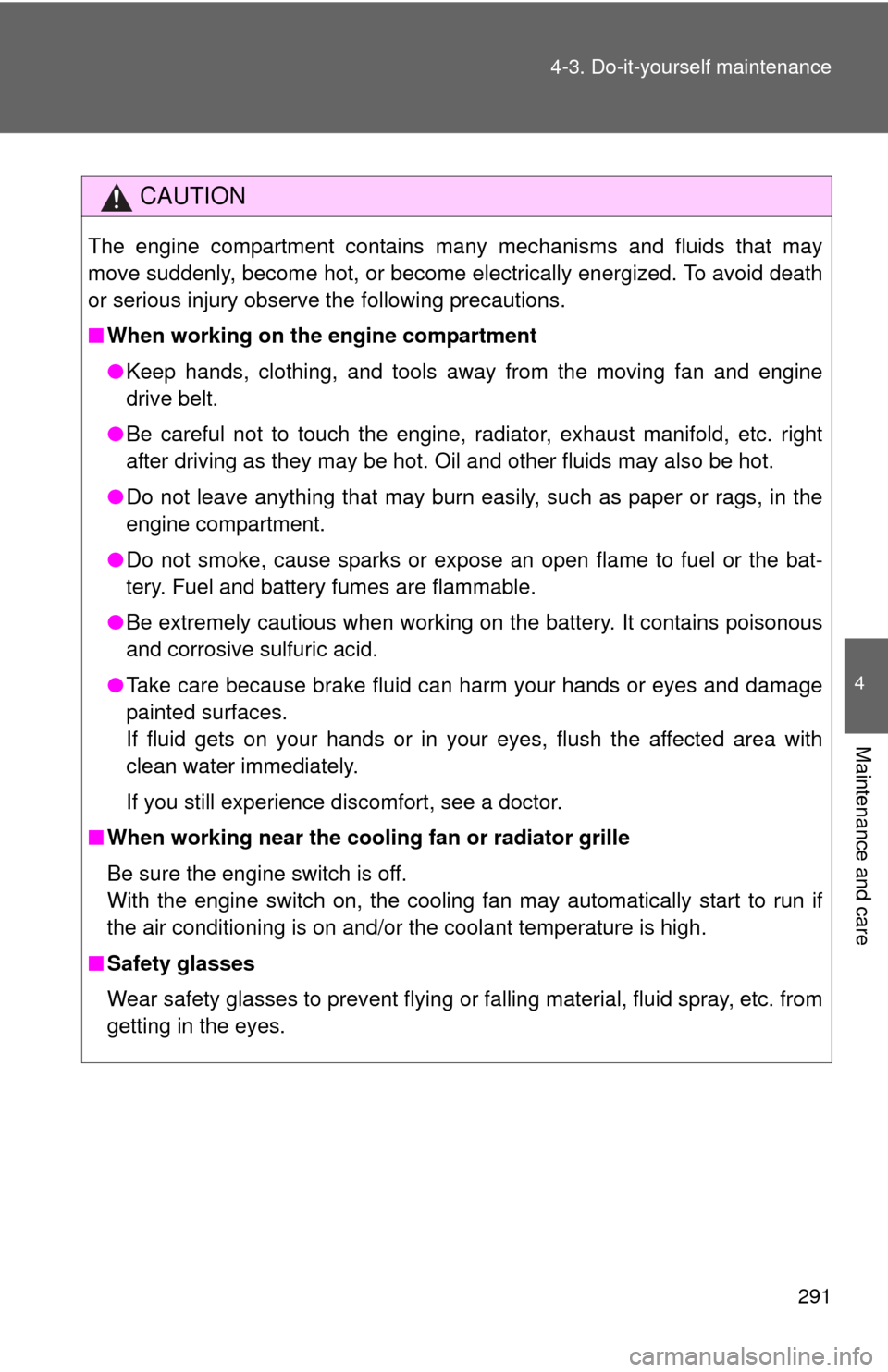
291 4-3. Do-it-yourself maintenance
4
Maintenance and care
CAUTION
The engine compartment contains many mechanisms and fluids that may
move suddenly, become hot, or become electrically energized. To avoid death
or serious injury observe the following precautions.
■When working on the engine compartment
●Keep hands, clothing, and tools away from the moving fan and engine
drive belt.
●Be careful not to touch the engine, radiator, exhaust manifold, etc. right
after driving as they may be hot. Oil and other fluids may also be hot.
●Do not leave anything that may burn easily, such as paper or rags, in the
engine compartment.
●Do not smoke, cause sparks or expose an open flame to fuel or the bat-
tery. Fuel and battery fumes are flammable.
●Be extremely cautious when working on the battery. It contains poisonous
and corrosive sulfuric acid.
●Take care because brake fluid can harm your hands or eyes and damage
painted surfaces.
If fluid gets on your hands or in your eyes, flush the affected area with
clean water immediately.
If you still experience discomfort, see a doctor.
■When working near the cooling fan or radiator grille
Be sure the engine switch is off.
With the engine switch on, the cooling fan may automatically start to run if
the air conditioning is on and/or the coolant temperature is high.
■Safety glasses
Wear safety glasses to prevent flying or falling material, fluid spray, etc. from
getting in the eyes.
Page 320 of 439
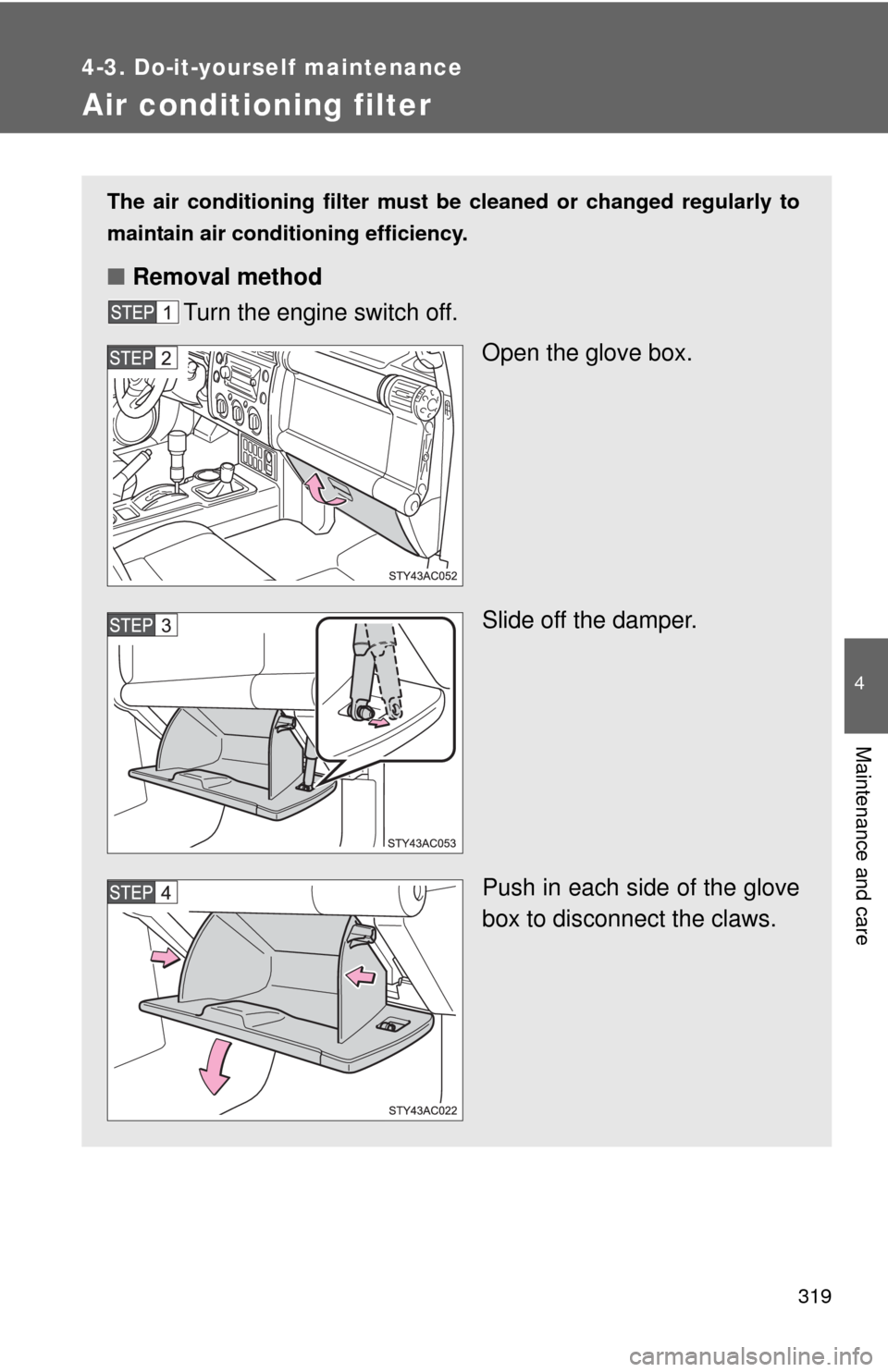
319
4-3. Do-it-yourself maintenance
4
Maintenance and care
Air conditioning filter
The air conditioning filter must be cleaned or changed regularly to
maintain air conditioning efficiency.
■Removal method
Turn the engine switch off.
Open the glove box.
Slide off the damper.
Push in each side of the glove
box to disconnect the claws.
Page 321 of 439
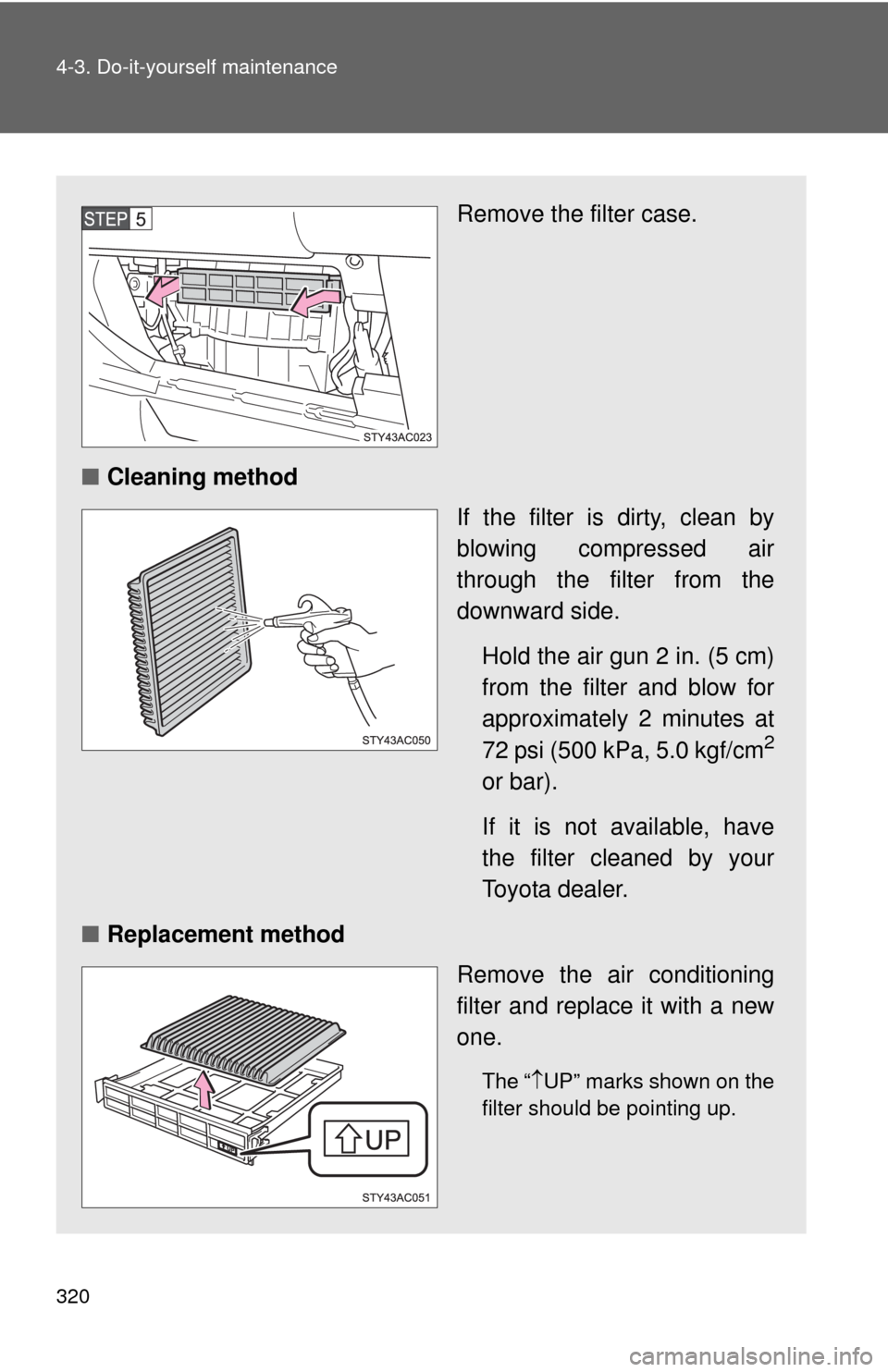
320 4-3. Do-it-yourself maintenance
Remove the filter case.
■Cleaning method
If the filter is dirty, clean by
blowing compressed air
through the filter from the
downward side.
Hold the air gun 2 in. (5 cm)
from the filter and blow for
approximately 2 minutes at
72 psi (500 kPa, 5.0 kgf/cm
2
or bar).
If it is not available, have
the filter cleaned by your
Toyota dealer.
■Replacement method
Remove the air conditioning
filter and replace it with a new
one.
The“UP” marks shown on the
filter should be pointing up.
Page 322 of 439
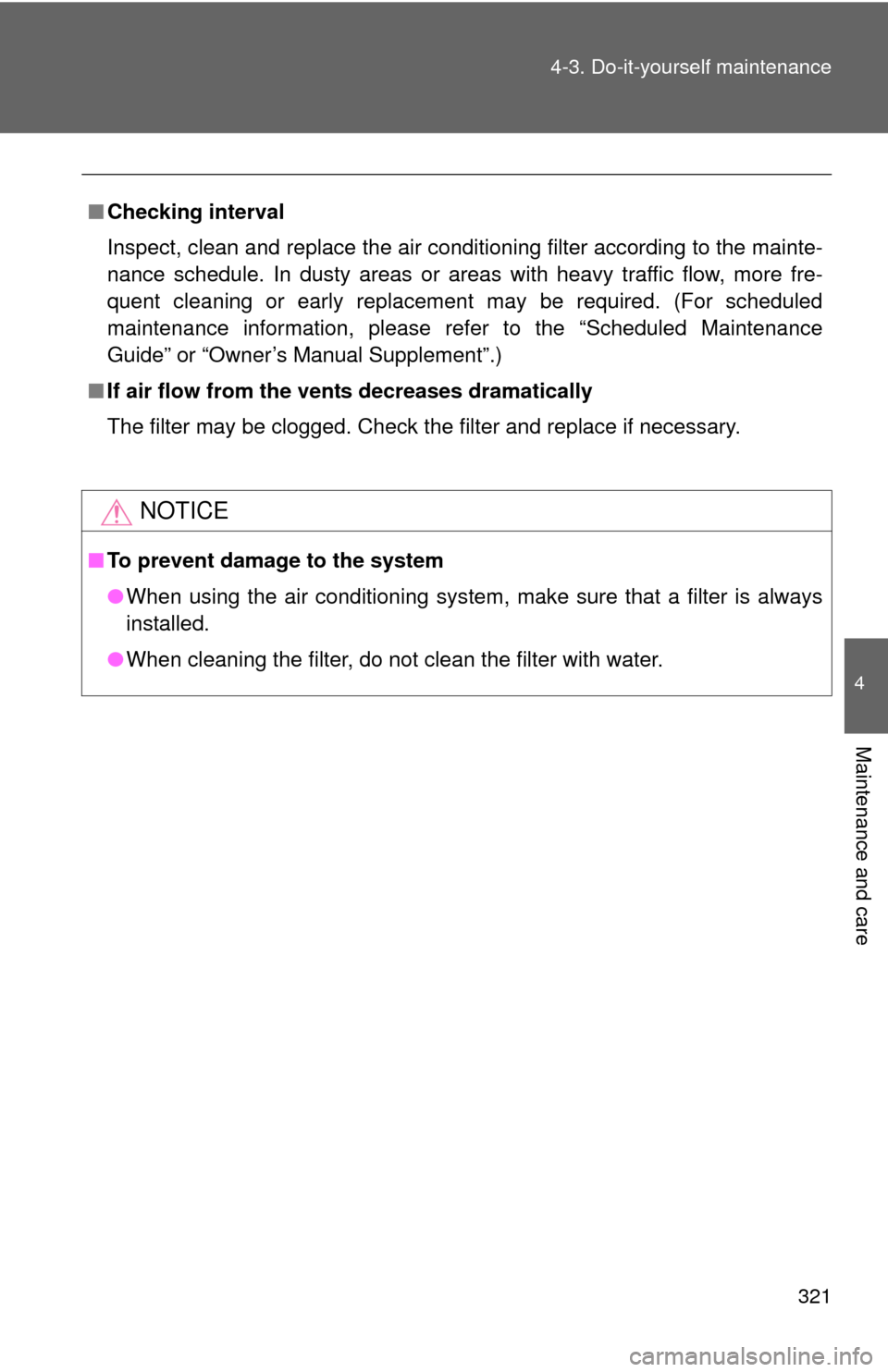
321 4-3. Do-it-yourself maintenance
4
Maintenance and care
■Checking interval
Inspect, clean and replace the air conditioning filter according to the mainte-
nance schedule. In dusty areas or areas with heavy traffic flow, more fre-
quent cleaning or early replacement may be required. (For scheduled
maintenance information, please refer to the “Scheduled Maintenance
Guide” or “Owner’s Manual Supplement”.)
■If air flow from the vents decreases dramatically
The filter may be clogged. Check the filter and replace if necessary.
NOTICE
■To prevent damage to the system
●When using the air conditioning system, make sure that a filter is always
installed.
●When cleaning the filter, do not clean the filter with water.
Page 331 of 439
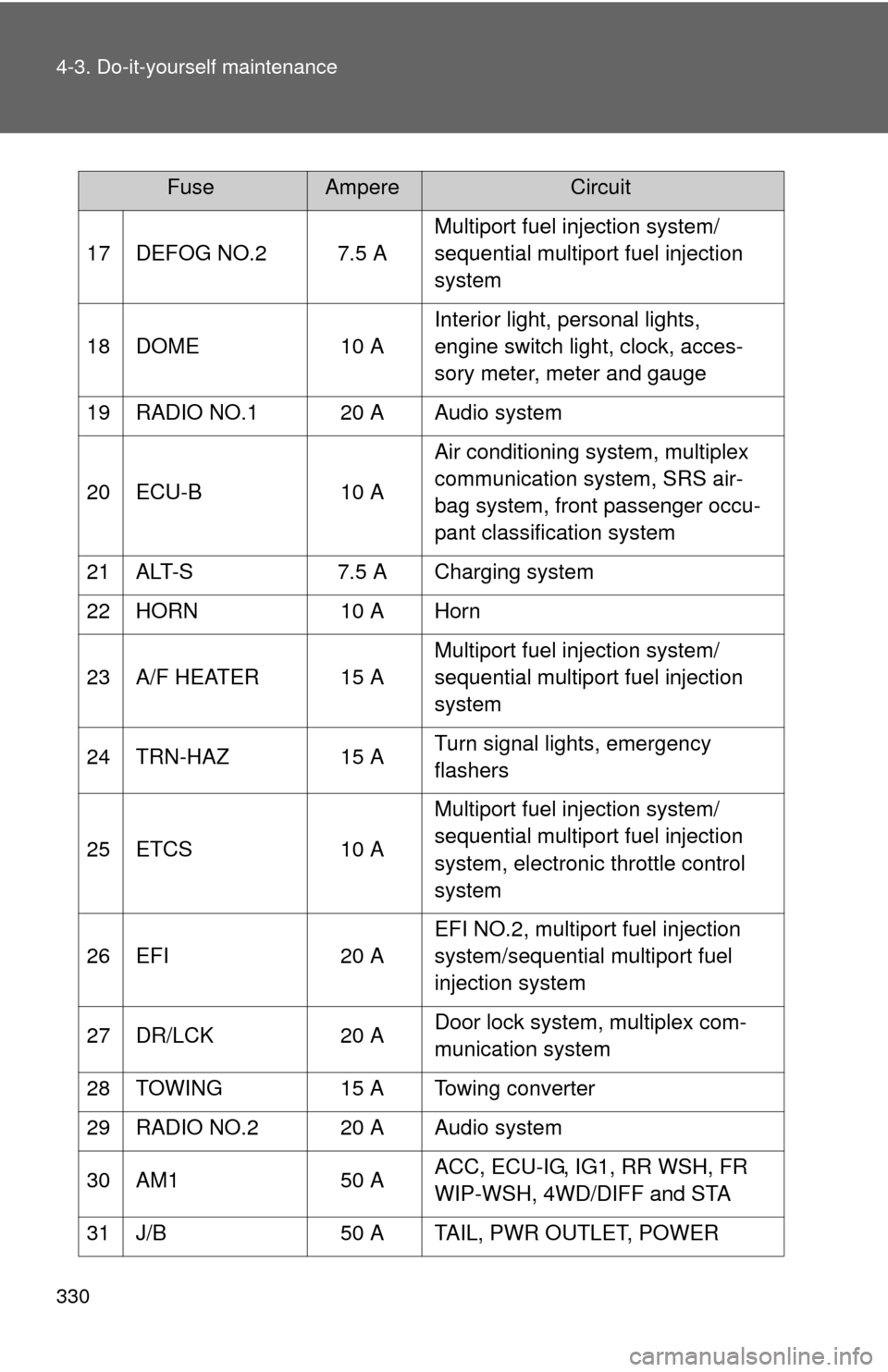
330 4-3. Do-it-yourself maintenance
17 DEFOG NO.2 7.5 AMultiport fuel injection system/
sequential multiport fuel injection
system
18 DOME 10 AInterior light, personal lights,
engine switch light, clock, acces-
sory meter, meter and gauge
19 RADIO NO.1 20 A Audio system
20 ECU-B 10 AAir conditioning system, multiplex
communication system, SRS air-
bag system, front passenger occu-
pant classification system
21 ALT-S 7.5 A Charging system
22 HORN 10 A Horn
23 A/F HEATER 15 AMultiport fuel injection system/
sequential multiport fuel injection
system
24 TRN-HAZ 15 ATurn signal lights, emergency
flashers
25 ETCS 10 AMultiport fuel injection system/
sequential multiport fuel injection
system, electronic throttle control
system
26 EFI 20 AEFI NO.2, multiport fuel injection
system/sequential multiport fuel
injection system
27 DR/LCK 20 ADoor lock system, multiplex com-
munication system
28 TOWING 15 A Towing converter
29 RADIO NO.2 20 A Audio system
30 AM1 50 AACC, ECU-IG, IG1, RR WSH, FR
WIP-WSH, 4WD/DIFF and STA
31 J/B 50 A TAIL, PWR OUTLET, POWER
FuseAmpereCircuit
Page 332 of 439
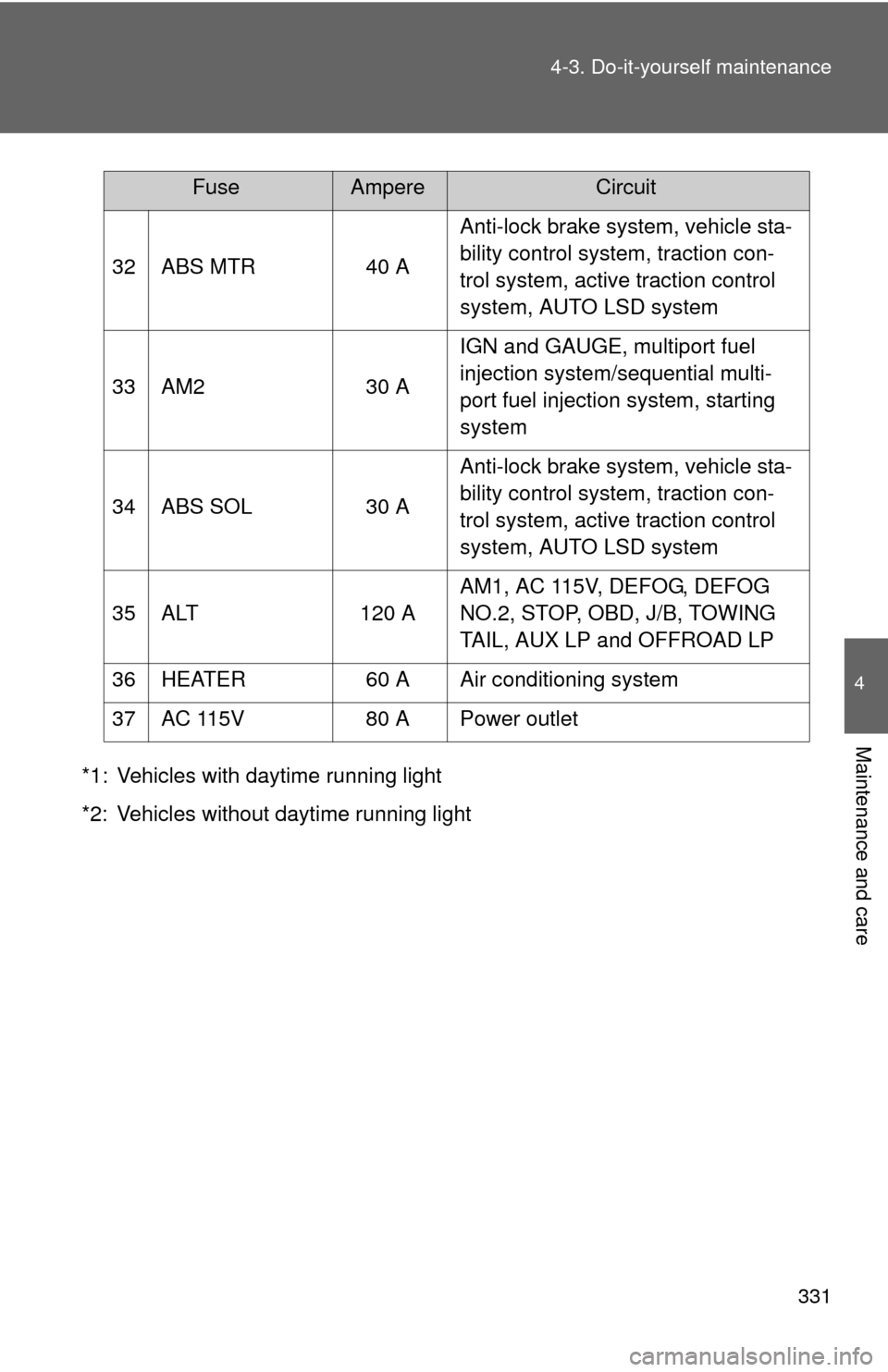
331 4-3. Do-it-yourself maintenance
4
Maintenance and care
*1: Vehicles with daytime running light
*2: Vehicles without daytime running light32 ABS MTR 40 AAnti-lock brake system, vehicle sta-
bility control system, traction con-
trol system, active traction control
system, AUTO LSD system
33 AM2 30 AIGN and GAUGE, multiport fuel
injection system/sequential multi-
port fuel injection system, starting
system
34 ABS SOL 30 AAnti-lock brake system, vehicle sta-
bility control system, traction con-
trol system, active traction control
system, AUTO LSD system
35 ALT 120 AAM1, AC 115V, DEFOG, DEFOG
NO.2, STOP, OBD, J/B, TOWING
TAIL, AUX LP and OFFROAD LP
36 HEATER 60 A Air conditioning system
37 AC 115V 80 A Power outlet
FuseAmpereCircuit